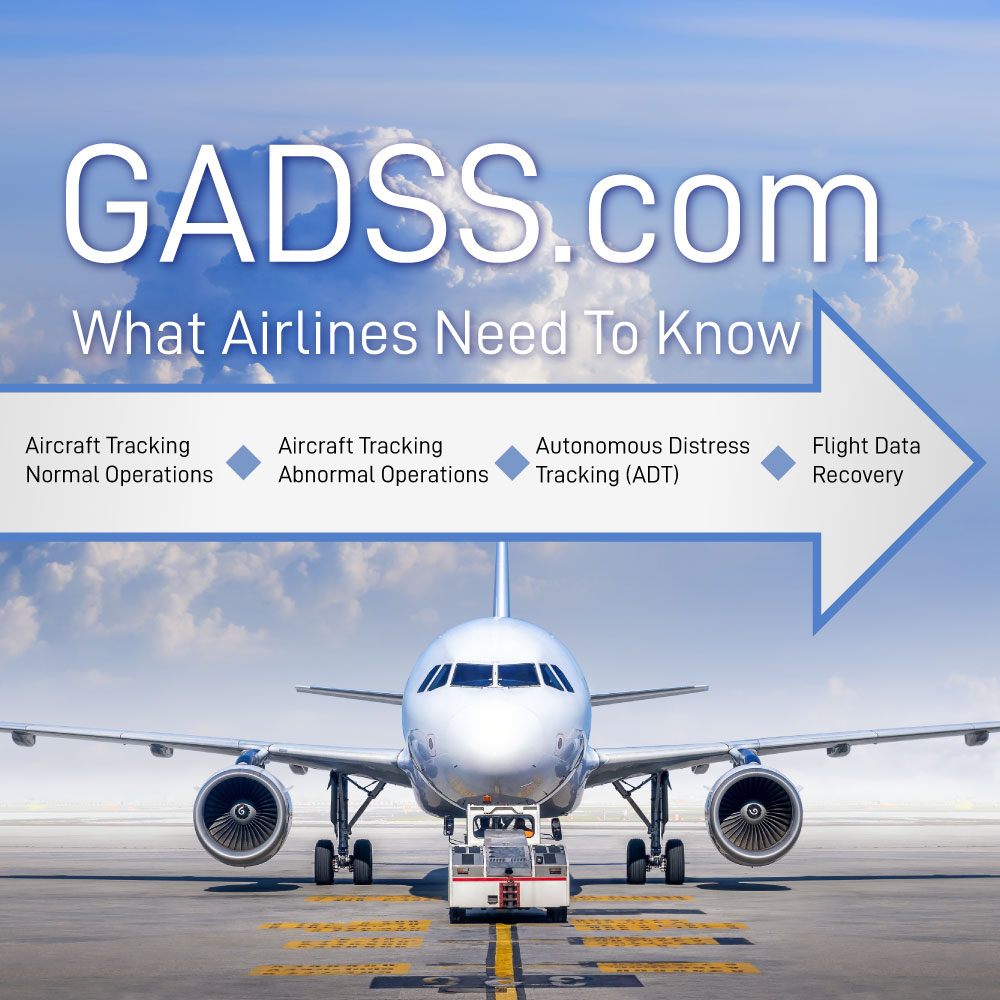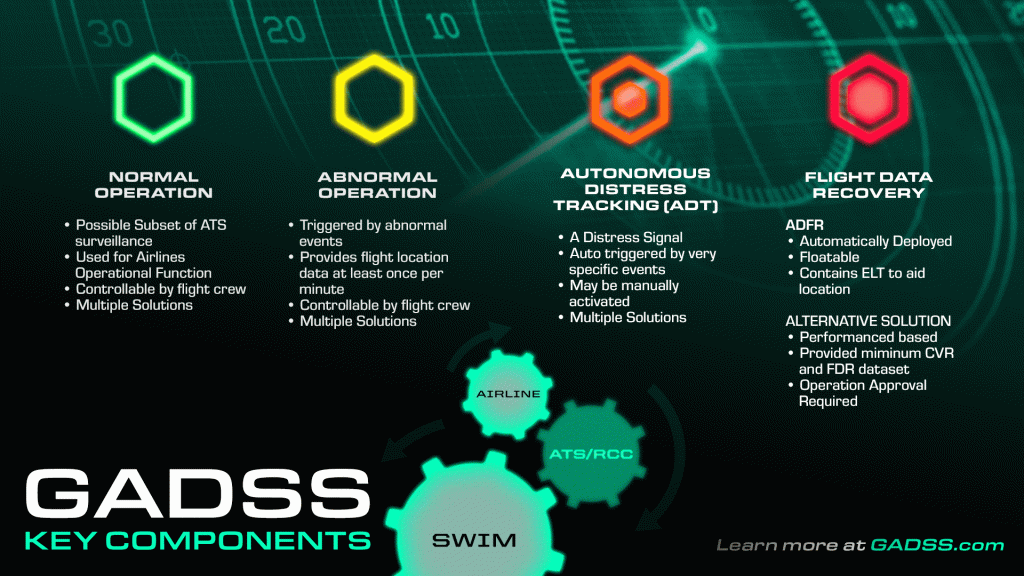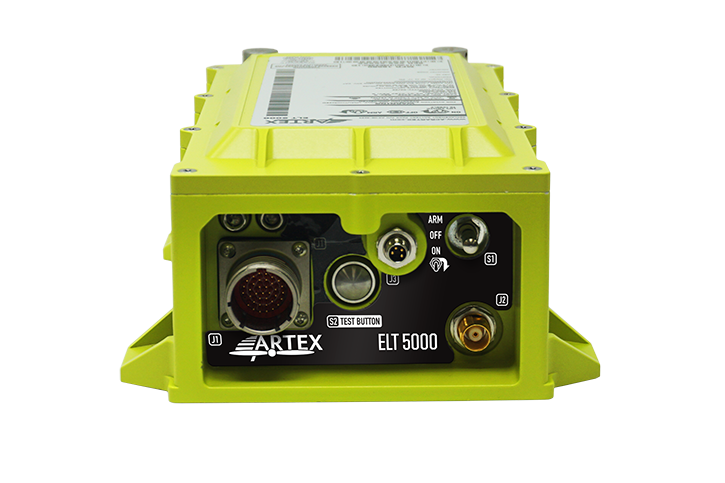 ELT DT
ELT DT
GADSS.com - Airline Information Resource
Posted on April 19, 2023
With the introduction of the Global Aeronautical Distress and Safety System (GADSS) being implemented into the commercial aviation market, here is a valuable resource to understand the key benefits of selecting a First Generation ELT with Distress Tracking or ELT DT.
Want to learn more about why you need a GADSS Compliant Distress Tracking ELT:
Contact James Hunter at +1 954-612-9592 or james.hunter@acrartex.com
Why Choose ARTEX? Because They Do!

What Is GADSS or Global Aeronautical Distress and Safety System?
GADSS, or Global Aeronautical Distress and Safety System (GADSS) will address all phases of flight under all circumstances including distress. GADSS will maintain an up‐to‐date record of the aircraft progress and, in case of a crash, forced landing or ditching, the location of survivors, the aircraft and recoverable flight data.
GADSS is designed to increase the effectiveness of the current alerting of search and rescue services for the aviation industry by addressing a number of key improvement areas which addresses all phases of flight under all circumstances including distress.
The three main functions of the GADSS are:

- Aircraft Tracking
- The aircraft position information needs to be updated and available for Air
Traffic Services (ATS) at least once per 15 minutes.
- The aircraft position information needs to be updated and available for Air
- Autonomous Distress Tracking or ADT
- The aircraft position information will be transmitted, without the need for
flight crew action, at least once every minute when an aircraft is in a
distress condition.
- The aircraft position information will be transmitted, without the need for
- Post Flight Localization and Recovery
- The accurate aircraft position information (1 NM or better) is provided to
Search and Rescue (SAR) services.
- The accurate aircraft position information (1 NM or better) is provided to

What is an ELT DT and how does it operate?
The ICAO Global Aeronautical Distress Safety System outlines specific requirements for Autonomous Distress Tracking of aircraft for commercial air transport. In addition, the European Union has adopted EASA requirements for the Location of Aircraft in Distress. The mandate is effective January 1, 2025 with applicability to aircraft issued an individual certificate of airworthiness issued after January 1, 2024.
There is no specific technology prescribed, however consideration to implement a solution must incorporate the aircraft equipment, aircraft integration, worldwide data infrastructure, ATSU/RCC connectivity, and airline familiarity. In this complex environment, the Emergency Locator Transmitter or ELT (DT) has risen to be the solution of choice for most major aircraft manufacturers including Boeing, Embraer, and Airbus due to its readiness in all these areas.
A Distress Tracking ELT can accept a distress trigger signal from the Autonomous Distress Trigger (ADT) system while in flight and can also have the function of crash survivability like a traditional ELT for location after the crash. The message structure and transmission characteristics are adapted to be properly identified as an aircraft in distress. A mandatory GNSS receiver, independent of the aircraft GNSS, provide aircraft position during a distress. The ELT (DT) also has a cancellation function which is not present on existing ELTs .
The International Cospas-Sarsat Program is a treaty-based, nonprofit, intergovernmental humanitarian cooperative of more than 40 nations and agencies dedicated to detecting and locating distress alerts are and forwarding location information to over 200 countries and territories at no cost to the receiving government agencies.
The Cospas-Sarsat system detects and locates 406 MHz radio beacons activated from aircraft, vessels and by persons. Position information is independently ascertained from the beacon signal without the need for a GNSS receiver. For the ELT (DT) in aircraft, however, we have noted that the GNSS receiver is mandatory to ascertain a reliability location of an aircraft at flight speeds.
The system utilizes a network of satellites that provide coverage anywhere on Earth. The satellites are in Low Earther Orbit (LEO), Geosynchronous Orbit (GEO), and the more recent deployment of Middle Earth Orbit (MEO). These satellites relay the distress signal from the beacon location to the ground segment.
The Ground Segment consists of several satellite downlink receiving, and signal processing ground stations called Local User Terminals (LUTs). Mission control centers (MCC) that exchange, route and distribute the distress alert data (particularly beacon location data) provided by the LUTs. Rescue Coordination Centers (RCC) which receive the alert data and prosecute the rescue. In the case of a Distress Tracking ELT, the RCC communicates with the applicable Air Traffic Service Unit and then the airline.
What is the Difference between First Generation and Second-Generation Beacons Distress Tracking ELT for GADSS?
The ELT (DT) transmits a distress message through the Cospas Sarsat system on the frequency of 406 MHz. How this transmission takes place and how the data is encoded is the basis for exploring the First-Generation Beacon (FGB) technology and the Second-Generation Beacon technology (SGB). Fundamentally, from an operational and carriage requirement perspective, there is no difference to the airline operator.
The Second-Generation Beacon technology is based on a different modulation technique known as spread spectrum. In addition, the location schema using the MEOSAR satellites allow for faster and more reliable independent location. For example, spread-spectrum signal schema allows for better penetration of triple canopy and ocean weather effects, vital in an inland or maritime Search and Rescue case. However, this is less inapplicable for an aircraft moving in flight. The SGB technology allows for greater static resolution of the GNSS (i.e. when the aircraft is not moving). SGB waveform format allows for future extensibility of more data. These future changes would drive re-certification of the SGB Distress Tracking ELT.
Here is the key to remember when comparing technologies. The ICAO Requirement is to track the position of the aircraft at least once every minute, to establish to a reasonable extent, the accident location to within 6 nautical miles. The European requirements is to locate the point of end of flight for a survivable accident with an accuracy of 200m. Both FGB and SGB are required to have a GNSS receivers which easily meet this requirement. Both FGB and SGB operate on the Cospas Sarsat MEOSAR satellite network for better reliability. From an airline operator perspective, the form, fit, and function of the technologies are the same.
When Would a GADSS Mandated Transition from First Generation to Second Generation Beacons take place?
Similar to the operational question of whether First Generation Beacon monitoring would cease, there is no anticipated mandate to transition from First Gen to Second Gen ELTs. There is no driving force to do so.
There are examples of regulatory agencies and national authorities mandating the usage of new safety equipment. GADSS is a perfect example. GADSS first appeared in regulations in 2018; four years after the disappearance of Malaysia Airlines flight MH370 in 2014 and 9 years after the Air France flight AF447 accident in 2009. The GADSS ADT mandate has now moved from 2021 to 2023 to 2025. GADSS ADT represents a significant change in flight safety, and it still took over well over a decade to realize.
The other the Automatic Dependent Surveillance–Broadcast or ADS-B mandate in the United States which transitioned from 2006 to 2020; and yet as of today, many airlines have waivers requesting more times.
The point is that First Generation Beacons are not going away and will continue to dominate the market for a few decades. Boeing, Airbus, Embraer, and some Bizjets have all chosen FGB Distress Tracking ELT for their aircraft platforms, so the FGB ELT (DT) populations will continue to grow faster than SGB ELT (DT) installations.
The technology differences between the FGB and SGB ELT (DT) demonstrate no significant impact in form, fit, and function for autonomous distress tracking. To open this argument would invite the inclusion of other ADT technologies such as space-based ADS-B and Satellite communications and tracking. The GADSS ADT mandate is technology agnostic, so there is no driver to mandate a particular solution.
There is really no basis or risk that SGB ELT (DT) will be mandated over FGB ELT (DT). Again, the large population of FGB beacons, the regulatory obligation to protect public safety, no operation differences in technology, and no driver to mandate GADSS technology protects airline investments in FGB ELT (DT).
Will First Generation Beacons cease to be monitored, and allowed once Second Generation Beacons become available?
According to data provided by Cospas-Sarsat, the First-Generation Beacon population has steadily grown over the last 30 years. It is assumed that an ELT remains in service for 10-18 years on an aircraft. The current FGB beacon population is estimated to be at about 2 million beacons; of that, about 250,000 are ELTs. The projections of FGB beacon populations through 2030 are projected to be 2.6 million with over 300,000 ELTs. As of 2023, there are no SGB on the market and populations of SGB beacons will experience a slow adoption rate in the market due to low demand.
Airlines need not be concerned whether FGB Distress Tracking ELT will cease to be monitored or even allowed for carriage requirements.
First, FGB beacons dominate the market and have lifetimes of at least a decade or longer. Search and Rescue organizations would not allow a safety device not to be monitored and responded to. This would jeopardize public safety worldwide, on land, sea, and air. It is estimated that it would take at least two decades for FGB beacons to experience significant attrition for SAR agencies to take a different position.
There is some precedent for regulatory agencies and national authorities to cease the usage of safety equipment and require a retrofit of equipment. A useful example to show how long this takes, is the cessation of the monitoring of 121.5 MHz ELTs in favor of 406 MHz ELTs. This transition took place because of significant and substantive technical advances in both the ELT as well as the space and ground infrastructure. The transition and outreach occurred from 1999-2009, the sale of were prohibited by 2018, and yet aircraft with previously installed 121.5 MHz ELTs are still permitted to fly in the USA.
The large population of FGB beacons and the regulatory obligation to protect public safety highlight upside in leveraging the proven and mature technology of FGB ELT (DT). No better reasons to protect airline investments in FGB ELT(DT).
























